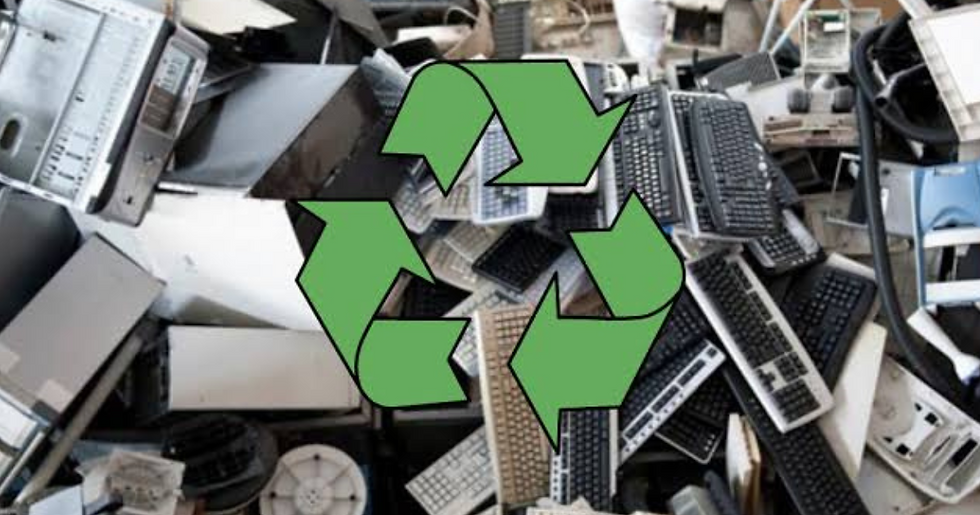E-WASTE EXPLAINED: Navigating the Environmental Impact of Discarded Electronics
- Youth for Environment in Schools Organization YES-O
- Nov 20, 2023
- 3 min read
Updated: Nov 27, 2023

In the age of rapidly advancing technology, our lives are intricately interwoven with electronic devices. From smartphones and laptops to refrigerators and televisions, these gadgets have become indispensable in our daily routines. However, the inevitable consequence of our tech-driven lifestyle is the generation of electronic waste, or e-waste. In this article, we will explore what happens to old electronics, unravel the environmental impact of electronic waste, and underscore the critical importance of recycling to mitigate its adverse effects.
The Escalating Issue of E-Waste

Electronic waste comprises discarded electronic devices that have reached the end of their life cycle. With the rapid pace of technological innovation, our gadgets quickly become obsolete, leading to an ever-growing mountain of e-waste. Unfortunately, improper disposal and inadequate recycling of electronic devices pose significant environmental and health risks.
Environmental Impact of E-Waste
Toxic Chemicals

Many electronic devices contain hazardous materials such as lead, mercury, cadmium, and brominated flame retardants. When improperly disposed of in landfills or incinerated, these toxins can leach into the soil and water, posing serious health risks to humans and wildlife.
Resource Depletion

Electronics contain valuable resources like gold, silver, copper, and rare earth metals. Discarding them without proper recycling means losing the opportunity to recover these precious materials and increases the demand for mining, leading to environmental degradation.
Greenhouse Gas Emissions

The manufacturing and disposal of electronic devices contribute to greenhouse gas emissions. Extracting raw materials, manufacturing components, and the energy-intensive processes involved in e-waste management all contribute to the carbon footprint of our electronic devices.
Energy Consumption

Electronic devices consume significant energy throughout their life cycle, from production to usage. The energy expended in manufacturing new devices far exceeds the energy saved by recycling, making it imperative to extend the lifespan of electronics through proper disposal and recycling.
The Journey of E-Waste: What Happens to Old Electronics?

Collection

The first step in managing e-waste is the collection of discarded electronics. This can occur through designated collection centers, electronic recycling events, or even through manufacturer take-back programs.
Sorting and Dismantling

Once collected, e-waste is sorted to identify components for reuse, recycling, or proper disposal. Devices are then dismantled, separating materials like plastics, metals, and circuit boards.
Material Recovery

Valuable materials such as gold, silver, copper, and palladium are recovered through various methods. These materials are then sent to manufacturers for reuse in the production of new electronics.
Safe Disposal

Components that cannot be recycled are disposed of in an environmentally responsible manner, often in specialized facilities equipped to handle hazardous materials. This prevents the release of toxins into the environment.
The Importance of Recycling Old Gadgets

Conservation of Resources

Recycling old gadgets helps conserve valuable resources by extracting and reusing materials from discarded electronics. This reduces the need for resource-intensive mining and lowers the environmental impact associated with raw material extraction.
Reduction of Environmental Pollution

Proper recycling prevents hazardous materials from leaching into the environment. By keeping toxic substances out of landfills and water systems, we protect ecosystems and human health.
Energy Savings

Recycling requires less energy than mining and refining raw materials. By recycling electronic devices, we contribute to energy savings and reduce the carbon footprint associated with the manufacturing of new gadgets.
Prevention of E-Waste Dumping

Recycling helps curb the illegal export and dumping of e-waste in developing countries, where inadequate regulations can lead to environmental degradation and health hazards for local communities.
Encouraging Circular Economy

Recycling promotes the concept of a circular economy, where products and materials are reused, refurbished, and recycled, minimizing waste and maximizing the lifespan of products.
Conclusion: A Call to Responsible Electronics Management

As consumers, we bear a collective responsibility for the environmental impact of our electronic devices. By understanding the journey of e-waste and the importance of recycling, we can make informed choices that contribute to a more sustainable and eco-friendly future. Recycling old gadgets is not just a matter of responsible waste management; it is a crucial step towards mitigating the environmental challenges posed by the rapidly growing mountain of electronic waste. Let's embark on a journey towards responsible electronics consumption, recycling, and advocacy for a healthier planet and a sustainable future.




Comments